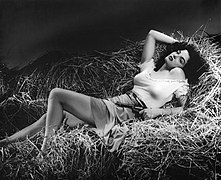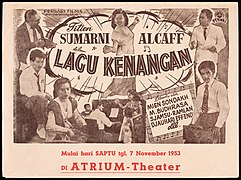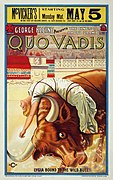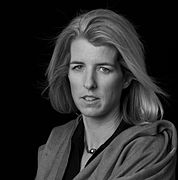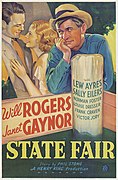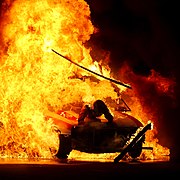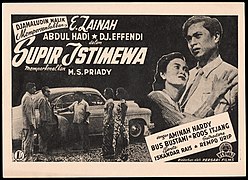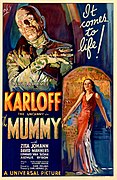Portail : Film
Statut de maintenance du portail : (juin 2018)
Please take care when editing, especially if using automated editing software. Learn how to update the maintenance information here. |
Wikipedia portal for content related to Film Rubriques du portail Activités Culture Géographie Santé Histoire Mathématiques Nature Personnes Philosophie La religion Société Technologie Portail aléatoire
Le portail du cinéma
 Homme travaillant avec un projecteur de cinéma dans une salle de cinéma, 1958
Homme travaillant avec un projecteur de cinéma dans une salle de cinéma, 1958
 Un film – également appelé film , film , image animée ou photoplay – est une œuvre d’ art visuel qui simule des expériences et communique autrement des idées, des histoires, des perceptions, des sentiments, la beauté ou l’atmosphère grâce à l’utilisation d’images en mouvement. Ces images sont généralement accompagnées de sons et, plus rarement, d’autres stimulations sensorielles. Le mot « cinéma », abréviation de cinématographie , est souvent utilisé pour désigner le cinéma et l’ industrie cinématographique , et la forme d’ art qui en est le résultat. ( Article complet… )
Un film – également appelé film , film , image animée ou photoplay – est une œuvre d’ art visuel qui simule des expériences et communique autrement des idées, des histoires, des perceptions, des sentiments, la beauté ou l’atmosphère grâce à l’utilisation d’images en mouvement. Ces images sont généralement accompagnées de sons et, plus rarement, d’autres stimulations sensorielles. Le mot « cinéma », abréviation de cinématographie , est souvent utilisé pour désigner le cinéma et l’ industrie cinématographique , et la forme d’ art qui en est le résultat. ( Article complet… )
Actualiser avec les nouvelles sélections ci-dessous (purge) Éditer
Articles en vedette – charger un nouveau lot
![]() Les articles en vedette sont affichés ici, qui représentent certains des meilleurs contenus sur Wikipedia anglais.
Les articles en vedette sont affichés ici, qui représentent certains des meilleurs contenus sur Wikipedia anglais.
-
![]() The Thing est un film d’horreurde science-fiction américain de 1982 réalisé par John Carpenterà partir d’un scénario de Bill Lancaster. Basé sur le roman de 1938 de John W. Campbell Jr. Qui va là-bas? , il raconte l’histoire d’un groupe de chercheurs américains en Antarctiquequi rencontrent la “Chose” éponyme, une forme de vie extraterrestre parasiteorganismes. Le groupe est submergé par la paranoïa et les conflits alors qu’ils apprennent qu’ils ne peuvent plus se faire confiance et que l’un d’eux pourrait être la Chose. Le film met en vedette Kurt Russell en tant que pilote d’hélicoptère de l’équipe, RJ MacReady , et met en vedette A. Wilford Brimley , TK Carter , David Clennon , Keith David , Richard Dysart , Charles Hallahan , Peter Maloney , Richard Masur , Donald Moffat , Joel Polis et Thomas G. Waites dans des rôles de soutien.
The Thing est un film d’horreurde science-fiction américain de 1982 réalisé par John Carpenterà partir d’un scénario de Bill Lancaster. Basé sur le roman de 1938 de John W. Campbell Jr. Qui va là-bas? , il raconte l’histoire d’un groupe de chercheurs américains en Antarctiquequi rencontrent la “Chose” éponyme, une forme de vie extraterrestre parasiteorganismes. Le groupe est submergé par la paranoïa et les conflits alors qu’ils apprennent qu’ils ne peuvent plus se faire confiance et que l’un d’eux pourrait être la Chose. Le film met en vedette Kurt Russell en tant que pilote d’hélicoptère de l’équipe, RJ MacReady , et met en vedette A. Wilford Brimley , TK Carter , David Clennon , Keith David , Richard Dysart , Charles Hallahan , Peter Maloney , Richard Masur , Donald Moffat , Joel Polis et Thomas G. Waites dans des rôles de soutien.
La production a commencé au milieu des années 1970 comme une adaptation fidèle de la nouvelle, après The Thing from Another World de 1951 . The Thing est passé par plusieurs réalisateurs et scénaristes, chacun avec des idées différentes sur la façon d’aborder l’histoire. Le tournage a duré environ douze semaines, à partir d’août 1981, et s’est déroulé sur des plateaux réfrigérés à Los Angeles ainsi qu’à Juneau, en Alaska , et à Stewart, en Colombie-Britannique . Sur les 15 $ du film millions de dollars, 1,5 million de dollars ont été dépensés pour les effets de créature de Rob Bottin , un mélange de produits chimiques, de produits alimentaires, de caoutchouc et de pièces mécaniques transformé par sa grande équipe en un extraterrestre capable de prendre n’importe quelle forme. ( Article complet… ) -
![]()
![A black-and-white drawing of a sinking ship, exploding with thick, black smoke.]() A still from the film showing the RMS Lusitania engulfed in smoke after being torpedoed
A still from the film showing the RMS Lusitania engulfed in smoke after being torpedoed
The Sinking of the Lusitania (1918) is an American silent animated short film by cartoonist Winsor McCay. It is a work of propaganda re-creating the never-photographed 1915 sinking of the British liner RMS Lusitania. At twelve minutes it has been called the longest work of animation at the time of its release. The film is the earliest surviving animated documentary and serious, dramatic work of animation. The National Film Registry selected it for preservation in 2017.
In 1915, a German submarine torpedoed and sank the RMS Lusitania; 128 Americans were among the 1,198 dead. The event outraged McCay, but the newspapers of his employer William Randolph Hearst downplayed the event, as Hearst was opposed to the U.S. joining World War I. McCay was required to illustrate anti-war and anti-British editorial cartoons for Hearst’s papers. In 1916, McCay rebelled against his employer’s stance and began work on the patriotic Sinking of the Lusitania on his own time with his own money. ( Full article…) -
![]() Blade Runner is a 1982 science fiction film directed by Ridley Scott, and adapted by Hampton Fancher and David Peoples. Starring Harrison Ford, Rutger Hauer, Sean Young, and Edward James Olmos, it is an adaptation of Philip K. Dick’s 1968 novel Do Androids Dream of Electric Sheep? The film is set in a dystopian future Los Angeles of 2019, in which synthetic humans known as replicants are bio-engineered by the powerful Tyrell Corporation to work on space colonies. When a fugitive group of advanced replicants led by Roy Batty (Hauer) escapes back to Earth, burnt-out cop Rick Deckard (Ford) reluctantly agrees to hunt them down.
Blade Runner is a 1982 science fiction film directed by Ridley Scott, and adapted by Hampton Fancher and David Peoples. Starring Harrison Ford, Rutger Hauer, Sean Young, and Edward James Olmos, it is an adaptation of Philip K. Dick’s 1968 novel Do Androids Dream of Electric Sheep? The film is set in a dystopian future Los Angeles of 2019, in which synthetic humans known as replicants are bio-engineered by the powerful Tyrell Corporation to work on space colonies. When a fugitive group of advanced replicants led by Roy Batty (Hauer) escapes back to Earth, burnt-out cop Rick Deckard (Ford) reluctantly agrees to hunt them down.
Blade Runner initially underperformed in North American theaters and polarized critics; some praised its thematic complexity and visuals, while others critiqued its slow pacing and lack of action. It later became an acclaimed cult film regarded as one of the all-time best science fiction films. Hailed for its production design depicting a high-tech but decaying future, Blade Runner is often regarded as both a leading example of neo-noir cinema as well as a foundational work of the cyberpunk genre. The film’s soundtrack, composed by Vangelis, was nominated in 1982 for a BAFTA and a Golden Globe as best original score. ( Full article…) -
![]()
![A black-and-white film still. A giant mosquito plunges its proboscis into the side of a man's head. The man is lying down in bed, and has a horrified look in his open eye.]()
How a Mosquito Operates is a 1912 silent animated film by American cartoonist Winsor McCay. The six-minute short depicts a giant mosquito tormenting a sleeping man. The film is one of the earliest works of animation, and its technical quality is considered far ahead of its time. It is also known under the titles The Story of a Mosquito and Winsor McCay and his Jersey Skeeters.
McCay had a reputation for his proficient drawing skills, best remembered in the elaborate cartooning of the children’s comic strip Little Nemo in Slumberland he began in 1905. He delved into the emerging art of animation with the film Little Nemo (1911), and followed its success by adapting an episode of his comic strip Dream of the Rarebit Fiend into How a Mosquito Operates. McCay gave the film a more coherent story and more developed characterization than in the Nemo film, with naturalistic timing, motion, and weight in the animation. ( Full article…) -
![]() Cannibal Holocaust is a 1980 Italian cannibal horror film directed by Ruggero Deodato and written by Gianfranco Clerici. It stars Robert Kerman as Harold Monroe, an anthropologist from New York University who leads a rescue team into the Amazon rainforest to locate a crew of filmmakers. Played by Carl Gabriel Yorke, Francesca Ciardi, Perry Pirkanen, and Luca Barbareschi, the crew had gone missing while filming a documentary on local cannibal tribes. When the rescue team is only able to recover the crew’s lost cans of film, an American television station wishes to broadcast the footage as a sensationalized television special. Upon viewing the reels, Monroe is appalled by the team’s actions and objects to the station’s intent to air the documentary.
Cannibal Holocaust is a 1980 Italian cannibal horror film directed by Ruggero Deodato and written by Gianfranco Clerici. It stars Robert Kerman as Harold Monroe, an anthropologist from New York University who leads a rescue team into the Amazon rainforest to locate a crew of filmmakers. Played by Carl Gabriel Yorke, Francesca Ciardi, Perry Pirkanen, and Luca Barbareschi, the crew had gone missing while filming a documentary on local cannibal tribes. When the rescue team is only able to recover the crew’s lost cans of film, an American television station wishes to broadcast the footage as a sensationalized television special. Upon viewing the reels, Monroe is appalled by the team’s actions and objects to the station’s intent to air the documentary.
Produced as part of the contemporary cannibal trend of Italian exploitation cinema, Cannibal Holocaust was inspired by Italian media coverage of Red Brigades terrorism. The coverage included news reports that Deodato believed to be staged, an idea which became an integral aspect of the film’s story. Additional story elements were influenced by the documentaries of Mondo director Gualtiero Jacopetti, including the presentation of the documentary crew’s lost footage, which constitutes approximately half of the film. The treatment of this footage, which is noted for its visual realism, innovated the found footage style of filmmaking that was later popularized in American cinema by The Blair Witch Project. Cannibal Holocaust was filmed primarily on location in the Amazon rainforest of Colombia with a cast of indigenous tribes interacting with mostly inexperienced American and Italian actors recruited in New York City. ( Full article…) -
![]()
![]() Theatrical release poster
Theatrical release poster
Eraserhead is a 1977 American surrealist horror film written, directed, produced, and edited by David Lynch. Lynch also created its score and sound design, which included pieces by a variety of other musicians. Shot in black and white, it was Lynch’s first feature-length effort following several short films. Starring Jack Nance, Charlotte Stewart, Jeanne Bates, Judith Anna Roberts, Laurel Near, and Jack Fisk, it tells the story of a man who is left to care for his grossly deformed child in a desolate industrial landscape.
Eraserhead was produced with the assistance of the American Film Institute (AFI) during Lynch’s time studying there. It nonetheless spent several years in principal photography because of funding difficulties; donations from Fisk and his wife Sissy Spacek kept production afloat. It was shot on several locations owned by the AFI in California, including Greystone Mansion and a set of disused stables in which Lynch lived. Lynch and sound designer Alan Splet spent a year working on the film’s audio after their studio was soundproofed. The soundtrack features organ music by Fats Waller and includes the song ” In Heaven”, written and performed for the film by Peter Ivers, with lyrics by Lynch. ( Full article…) -
![]() The Mummy is a 1999 American fantasy action-adventure film written and directed by Stephen Sommers. It is a remake of the 1932 film of the same name, starring Brendan Fraser, Rachel Weisz, John Hannah, Kevin J. O’Connor, and Arnold Vosloo in the title role as the reanimated mummy. The film follows adventurer Rick O’Connell as he travels to Hamunaptra, the City of the Dead, with a librarian and her older brother, where they accidentally awaken Imhotep, a cursed high priest with supernatural powers.
The Mummy is a 1999 American fantasy action-adventure film written and directed by Stephen Sommers. It is a remake of the 1932 film of the same name, starring Brendan Fraser, Rachel Weisz, John Hannah, Kevin J. O’Connor, and Arnold Vosloo in the title role as the reanimated mummy. The film follows adventurer Rick O’Connell as he travels to Hamunaptra, the City of the Dead, with a librarian and her older brother, where they accidentally awaken Imhotep, a cursed high priest with supernatural powers.
Development of the film took years, with multiple screenplays and directors attached. In 1997, Stephen Sommers successfully pitched his version of a more adventurous and romantic take on the source material. Principal photography took place in Morocco and the United Kingdom; the crew endured dehydration, sandstorms, and snakes shooting on location in the Sahara desert. Industrial Light & Magic provided many of the visual effects, blending live-action footage and computer-generated imagery to create the titular monster. Jerry Goldsmith provided the orchestral score. ( Full article…) -
![]()
![A black-and-white advertisement]() Newspaper advertisement
Newspaper advertisement
Sorga Ka Toedjoe ( [ˈsɔrɡa kə ˈtudʒu]; vernacular Malay for Seventh Heaven; also advertised under the Dutch title In Den Zevenden Hemel) is a 1940 film from the Dutch East Indies (present-day Indonesia) directed by Joshua and Othniel Wong for Tan’s Film. It follows an older couple ( Kartolo and Annie Landouw) who are reunited by another, younger couple ( Roekiah and Djoemala) after years of separation. The black-and-white film, the first production by Tan’s Film after the departure of Rd Mochtar, featured kroncong music and was targeted at lower-class native audiences. It was a commercial and critical success. Roekiah and Djoemala took leading roles in three more films before Tan’s closed in 1942. Sorga Ka Toedjoe is now thought lost. ( Full article…) -
![]() Margarita with a Straw is a 2014 Indian Hindi-language drama film directed by Shonali Bose. It stars Kalki Koechlin as an Indian teenager with cerebral palsy who relocates to America for her undergraduate education and comes of age following her complex relationship with a blind girl, played by Sayani Gupta. Revathi, Kuljeet Singh, and William Moseley play supporting roles. Produced by Bose in partnership with Viacom18 Motion Pictures, Margarita with a Straw was co-written by Bose and Nilesh Maniyar. The film deals with the challenging concepts of sexuality, inclusion, self-love, and self-acceptance.
Margarita with a Straw is a 2014 Indian Hindi-language drama film directed by Shonali Bose. It stars Kalki Koechlin as an Indian teenager with cerebral palsy who relocates to America for her undergraduate education and comes of age following her complex relationship with a blind girl, played by Sayani Gupta. Revathi, Kuljeet Singh, and William Moseley play supporting roles. Produced by Bose in partnership with Viacom18 Motion Pictures, Margarita with a Straw was co-written by Bose and Nilesh Maniyar. The film deals with the challenging concepts of sexuality, inclusion, self-love, and self-acceptance.
Bose conceived the idea for the film in January 2011, during a conversation with Malini Chib—her cousin and a disability rights activist—about the latter’s desire to have a normal sex life. Inspired by Chib’s story, Bose wrote the first draft of the film’s script. After winning a Sundance Mahindra Global Filmmaker Award for the draft, she modified the script to reflect her own perspective, incorporating several personal experiences into the narrative. Bose completed the screenplay with co-writer Maniyar and the advisory council of the Sundance Institute. ( Full article…) -
![]() ? (also written Tanda Tanya, meaning Question Mark) is a 2011 Indonesian drama film directed by Hanung Bramantyo. It stars Revalina Sayuthi Temat, Reza Rahadian, Agus Kuncoro, Endhita, Rio Dewanto, and Hengky Sulaeman. The film focuses around Indonesia’s religious pluralism, which often results in conflict between different beliefs, represented in a plot that revolves around the interactions of three families, one Buddhist, one Muslim, and one Catholic. After undergoing numerous hardships and the deaths of several family members in religious violence, they are reconciled.
? (also written Tanda Tanya, meaning Question Mark) is a 2011 Indonesian drama film directed by Hanung Bramantyo. It stars Revalina Sayuthi Temat, Reza Rahadian, Agus Kuncoro, Endhita, Rio Dewanto, and Hengky Sulaeman. The film focuses around Indonesia’s religious pluralism, which often results in conflict between different beliefs, represented in a plot that revolves around the interactions of three families, one Buddhist, one Muslim, and one Catholic. After undergoing numerous hardships and the deaths of several family members in religious violence, they are reconciled.
Based on Bramantyo’s experiences as a mixed-race child, ? was meant to counter the portrayal of Islam as a “radical religion”. Owing to the film’s theme of religious pluralism and controversial subject matter, Bramantyo had difficulty finding backing. Eventually, Mahaka Pictures put forth Rp 5 billion ($600,000) to fund the production. Filming began on 5 January 2011 in Semarang. ( Full article…)
Image 1Image 2Image 3Image 4Image 5Image 6Image 7Image 8Image 9Image 10Show all
Plus d’articles en vedette
Images générales – charger un nouveau lot
Voici des images de divers articles liés au cinéma sur Wikipedia.
-
![(from Film industry)]()
Une équipe de tournage au milieu du XXe siècle
-
![]()
Cinématographe Lumière at the Institut Lumière, France (from History of film technology)
-
![]()
Charlie Chaplin (from History of film)
-
![]()
A scene from Raja Harishchandra (1913) – credited as the first full-length Indian motion picture. (from Film industry)
-
![]()
A frame from the Lumière brothers staged comedy film, L’Arroseur Arrosé (1895). (from History of film)
-
![]()
Poster for the 1956 Egyptian film Wakeful Eyes starring Salah Zulfikar (from History of film)
-
![]() The Pathé Brothers, by Adrien Barrère. (from History of film)
The Pathé Brothers, by Adrien Barrère. (from History of film) -
![]()
Nestor studio, 1911 (from Film industry)
-
![]()
Off Plus Camera Film Festival in Kraków, 2012, with Andrzej Seweryn, Daniel Olbrychski, and Wojciech Pszoniak on stage. (from Film industry)
-
![]()
The first two shots of As Seen Through a Telescope (1900), with the telescope POV simulated by the circular mask (from History of film)
-
![]()
Czermak’s 1855 Stereophoroskop (from History of film technology)
-
![]()
A production scene from the 1950 Hollywood film Julius Caesar starring Charlton Heston (from History of film)
-
![]()
An 1896 advertising poster with image from Lumière’s L’Arroseur arrosé (from History of film)
-
![]()
Poster for the Egyptian film Yahya el hub (1938). (from Film industry)
-
![]()
A.E. Smith filming The Bargain Fiend in the Vitagraph Studios in 1907. Arc floodlights hang overhead. (from History of film)
-
![]()
The two scenes making up Come Along, Do! (from History of film)
-
![]()
Discounted DVD home video film releases sold in the Netherlands (from Film industry)
-
![]()
Edward Raymond Turner’s three-color projector, 1902 (from History of film technology)
-
![]()
A still from The Story of the Kelly Gang (Australia, 1906; 80 min.) (from Film industry)
-
![]()
Animated GIF of Prof. Stampfer’s Stroboscopische Scheibe No. X (Trentsensky & Vieweg 1833) (from History of film technology)
-
![]()
Cinema admissions in 1995 (from History of film)
-
![]()
El Apóstol, the world’s first animated feature film, and Peludópolis, the first animated feature film with sound, were produced in cutout animation by Italian-Argentinian cartoonist Quirino Cristiani. (from History of film)
-
![]()
A single frame from the Humorous Phases of Funny Faces animation, showing the use of cut-out technique (from History of film)
-
![]()
Satyajit Ray, Indian Bengali film director (from History of film)
-
![A theatrical release poster for The Wizard of Oz (1939).]()
The Wizard of Oz (from History of film)
-
![]()
Poster for a Biograph Studios release from 1913 (from History of film)
-
Old Chinese Cinema in Qufu, Shandong (from Film industry)
-
![]()
Film still from Dickson Greeting (from History of film technology)
-
![]()
Georges Méliès (left) painting a backdrop in his studio (from History of film)
-
![]()
The Hollywood Sign (from Film industry)
-
![]()
The Berlin Wintergarten theatre was the site of the first movie presentations by the Skladanowsky brothers in November 1895, seen here in a 1940 photograph (from History of film technology)
-
![]()
London IMAX has the largest cinema screen in Britain with a total screen size of 520m2. (from Film industry)
-
![]()
William Friese-Greene (from Film industry)
-
![]()
GIF animation from retouched pictures of The Horse in Motion by Eadweard Muybridge (1879). (from History of film technology)
-
![]()
Hollywood Sign (from History of film)
-
![]()
A surviving two-color-component image from the first Technicolor feature film, The Gulf Between (1917) (from History of film technology)
-
![]()
Don Juan is the first feature-length film to utilize the Vitaphone sound-on-disc sound system with a synchronized musical score and sound effects, though it has no spoken dialogue. (from History of film)
-
![]()
“Abe Edgington,” owned by Leland Stanford; driven by C. Marvin, trotting at a 2-24 gait over the Palo Alto track, 15 June 1878 (from History of film)
-
![]()
A shot from Raja Harishchandra (1913), the first film of Bollywood. (from Film industry)
-
![]()
The Jazz Singer (1927), was the first full-length film with synchronized sound. (from History of film technology)
-
![]()
Complex vignette shot in die Austernprinzessin (The Oyster Princess) (from History of film)
-
![]()
Insert shot in Old Wives for New (Cecil B. DeMille, 1918) (from History of film)
-
![]()
The Babelsberg Studio near Berlin was the first large-scale film studio in the world (founded 1912) and the forerunner to Hollywood. It still produces global blockbusters every year. (from History of film)
Image 1Image 2Image 3Image 4Image 5Image 6Image 7Image 8Image 9Image 10Image 11Image 12Image 13Image 14Image 15Image 16Image 17Image 18Image 19Image 20Image 21Image 22Image 23Image 24Image 25Image 26Image 27Image 28Image 29Image 30Image 31Image 32Image 33Image 34Image 35Image 36Image 37Image 38Image 39Image 40Image 41Image 42Image 43Show all
Image sélectionnée
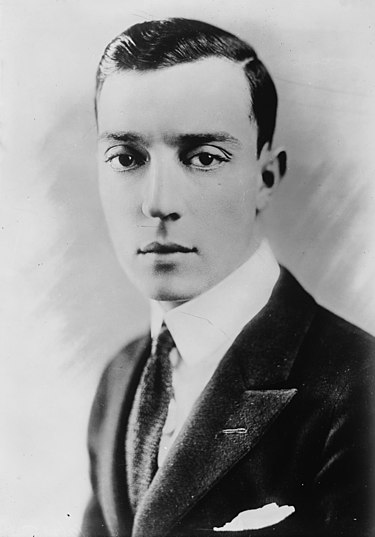
| Crédit : Bain News Service |
Buster Keaton (né Joseph Frank Keaton , 4 octobre 1895 – 1er février 1966) était unacteur et cinéaste américain de bande dessinée muette . Sa marque de fabrique était la comédie physique avec une expression stoïque et impassible sur son visage.
| Plus d’images sélectionnées |
Suite… |
Le saviez-vous…
- … qu’Alice du vendredi 13 est devenue un catalyseur pour le trope du film slasher consistant à tuer de manière inattendue le principal protagoniste survivant de la suite ?
- … que le film documentaire expérimental de 1995 de James Benning , Deseret , relate 140 ans d’histoire de l’Utah à travers 93 extraits du New York Times ?
- … qu’après s’être évadé de la prison de haute sécurité d’İmralı , Billy Hayes a écrit un livre sur l’évasion qui a ensuite été adapté en film ?
- … que la qualité de la répartie de Bruce Edwards avec sa co-vedette dans la série de films The Black Widow de 1947 a été comparée au combat verbal de Cary Grant et Rosalind Russell dans His Girl Friday ?
- … que l’acteur Joseph Holland a été accidentellement poignardé et grièvement blessé par Orson Welles , brandissant un couteau en acier, lors d’une production de Broadway en 1937 de Jules César de Shakespeare ?
Biographie sélectionnée – en montrer une autre
 Kiarostami en 2013
Kiarostami en 2013
Abbas Kiarostami ( persan : عباس کیارستمی [ʔæbˌbɒːs kijɒːɾostæˈmi] ( écouter )![]() ; 22 juin 1940 – 4 juillet 2016) était un réalisateur , scénariste , poète , photographe et producteur de films iranien . Cinéaste actif à partir de 1970, Kiarostami a participé à la production de plus de quarante films, dont des courts métrages et des documentaires. Kiarostami a été acclamé par la critique pour avoir réalisé la trilogie Koker (1987-1994), Close-Up (1990), The Wind Will Carry Us (1999) et Taste of Cherry (1997), qui a reçu la Palme d’Or auFestival de Cannes cette année-là . Dans des œuvres ultérieures, Copie certifiée (2010) et Like Someone in Love (2012), il a tourné pour la première fois hors d’Iran : en Italie et au Japon, respectivement. Ses films Où est la maison de l’ami ? , Close-Up et The Wind Will Carry Us ont été classés parmi les 100 meilleurs films étrangers dans un sondage des critiques réalisé en 2018 par BBC Culture. Close-Up a également été classé parmi les 50 plus grands films de tous les temps dans le célèbre sondage décennal Sight & Sound réalisé en 2012.
; 22 juin 1940 – 4 juillet 2016) était un réalisateur , scénariste , poète , photographe et producteur de films iranien . Cinéaste actif à partir de 1970, Kiarostami a participé à la production de plus de quarante films, dont des courts métrages et des documentaires. Kiarostami a été acclamé par la critique pour avoir réalisé la trilogie Koker (1987-1994), Close-Up (1990), The Wind Will Carry Us (1999) et Taste of Cherry (1997), qui a reçu la Palme d’Or auFestival de Cannes cette année-là . Dans des œuvres ultérieures, Copie certifiée (2010) et Like Someone in Love (2012), il a tourné pour la première fois hors d’Iran : en Italie et au Japon, respectivement. Ses films Où est la maison de l’ami ? , Close-Up et The Wind Will Carry Us ont été classés parmi les 100 meilleurs films étrangers dans un sondage des critiques réalisé en 2018 par BBC Culture. Close-Up a également été classé parmi les 50 plus grands films de tous les temps dans le célèbre sondage décennal Sight & Sound réalisé en 2012.
Kiarostami avait beaucoup travaillé comme scénariste , monteur, directeur artistique et producteur et avait conçu des génériques et du matériel publicitaire. Il était également poète, photographe, peintre, illustrateur et graphiste . Il faisait partie d’une génération de cinéastes de la Nouvelle Vague iranienne , un mouvement cinématographique persan qui a débuté à la fin des années 1960 et a mis l’accent sur l’utilisation du dialogue poétique et de la narration allégorique traitant de questions politiques et philosophiques. ( Article complet… )
| Liste des biographies sélectionnées |
|---|
|
Listes en vedette – charger un nouveau lot
![]() Selon un processus de révision, les listes en vedette sont considérées comme les meilleurs articles de liste sur Wikipedia anglais.
Selon un processus de révision, les listes en vedette sont considérées comme les meilleurs articles de liste sur Wikipedia anglais.
-
![]()
![]() Théron au Festival de Cannes 2015
Théron au Festival de Cannes 2015
Charlize Theron est une actrice et productrice sud-africaine-américaine qui a reçu divers prix et nominations, dont un Oscar et un Golden Globe Award . De plus, elle a été nominée pour deux Oscars, trois British Academy Film Awards et un Primetime Emmy Award . En 2005, Theron a reçu une étoile sur le Hollywood Walk of Fame pour sa contribution à l’industrie cinématographique.
En 1999, Theron a joué dans le drame de Lasse Hallström The Cider House Rules. Pour sa performance, elle a remporté le Bambi Award pour Shooting Star: Female et a été nominée pour le Satellite Award de la meilleure actrice dans un second rôle – Film . Le rôle révolutionnaire de Theron dans le drame policier biographique acclamé par la critique Monster (2003) lui a valu l’ Oscar de la meilleure actrice , le Critics’ Choice Movie Award de la meilleure actrice , le Screen Actors Guild Award for Outstanding Performance by a Female Actor in a Leading Role , le Golden Globe Award de la meilleure actrice dans un film dramatique, et elle a été nominée pour le prix BAFTA de la meilleure actrice dans un rôle principal . En 2005, Theron a joué dans le drame North Country de Niki Caro en tant que mère célibataire et ferronnerie victime de harcèlement sexuel. Sa performance a remporté le Desert Palm Achievement Award , le Hollywood Actress Award , et elle a été nominée pour l’Oscar de la meilleure actrice, le BAFTA Award de la meilleure actrice dans un rôle principal et le Golden Globe Award de la meilleure actrice dans un Film – Drame. ( Article complet… ) -
![]() Neerja is a 2016 Indian Hindi-language biographical thriller film directed by Ram Madhvani and produced by Atul Kasbekar. The film stars Sonam Kapoor as Neerja Bhanot and features Shekhar Ravjiani, Shabana Azmi and Yogendra Tiku among others in supporting roles. The film’s script and screenplay were penned by Saiwyn Quadras, the dialogue was written by Sanyuktha Chawla Sheikh, and the editing was handled by Monisha R Baldawa. Set in Karachi, the plot of Neerja centres on the Libyan-backed Abu Nidal Organization’s hijacking of Pan Am Flight 73 in Karachi, Pakistan, on 5 September 1986. The film is shown from the point of view of the flight’s head purser, Neerja Bhanot, who died saving passengers on the hijacked flight.
Neerja is a 2016 Indian Hindi-language biographical thriller film directed by Ram Madhvani and produced by Atul Kasbekar. The film stars Sonam Kapoor as Neerja Bhanot and features Shekhar Ravjiani, Shabana Azmi and Yogendra Tiku among others in supporting roles. The film’s script and screenplay were penned by Saiwyn Quadras, the dialogue was written by Sanyuktha Chawla Sheikh, and the editing was handled by Monisha R Baldawa. Set in Karachi, the plot of Neerja centres on the Libyan-backed Abu Nidal Organization’s hijacking of Pan Am Flight 73 in Karachi, Pakistan, on 5 September 1986. The film is shown from the point of view of the flight’s head purser, Neerja Bhanot, who died saving passengers on the hijacked flight.
Made on a budget of ₹200 million (US$3.1 million), Neerja was released on 19 February 2016, and grossed ₹1.35 billion (US$18 million) worldwide. The film won 31 awards from 45 nominations; its direction and performances of the cast members have received the most attention from award groups. ( Full article…) -
![]() 127 Hours is a 2010 British independent biographical adventure film directed by Danny Boyle. It stars James Franco in the principal role as real-life mountain climber Aron Ralston, whose hand was trapped under a boulder in a Utah ravine for more than five days in April 2003. Adapted from Ralston’s autobiography Between a Rock and a Hard Place, 127 Hours ‘s screenplay was written by Boyle and Simon Beaufoy. Distributors Fox Searchlight and Pathé gave the feature limited releases in the United States and United Kingdom on 5 November 2010 and 7 January 2011, respectively. It grossed £35.8 million at the box office by the end of its worldwide theatrical run. Rotten Tomatoes, a review aggregator surveyed 215 reviews and judged 93% to be positive.
127 Hours is a 2010 British independent biographical adventure film directed by Danny Boyle. It stars James Franco in the principal role as real-life mountain climber Aron Ralston, whose hand was trapped under a boulder in a Utah ravine for more than five days in April 2003. Adapted from Ralston’s autobiography Between a Rock and a Hard Place, 127 Hours ‘s screenplay was written by Boyle and Simon Beaufoy. Distributors Fox Searchlight and Pathé gave the feature limited releases in the United States and United Kingdom on 5 November 2010 and 7 January 2011, respectively. It grossed £35.8 million at the box office by the end of its worldwide theatrical run. Rotten Tomatoes, a review aggregator surveyed 215 reviews and judged 93% to be positive.
Additionally, 127 Hours appeared on more than two dozen movie reviewers’ Top Ten lists for the best movies of 2010.
The film has received honors for its direction, music, cinematography and writing, as well as for the lead performance by Franco. At the 68th Golden Globe Awards ceremony, 127 Hours earned three nominations: for Best Actor – Motion Picture Drama, Best Original Score and Best Screenplay. The picture was nominated in nine Satellite Award categories, including direction, score, sound, original song and visual effects. It also received nine nominations from the Broadcast Film Critics Association. The 64th British Academy Film Awards nominated it for eight of their awards, including Best Director, Best Editing, Best Music and Best Sound. Additionally, 127 Hours was nominated for the BAFTA Award for Best Film, but lost to The King’s Speech. It performed similarly at the 83rd Academy Awards, where it was nominated in six categories: Best Actor, Best Adapted Screenplay, Best Film Editing, Best Original Score, Best Original Song (for ” If I Rise”) and Best Picture, but lost respectively in all categories to The King’s Speech, The Social Network, and Toy Story 3. ( Full article…) -
![]()
![Bruce Willis at the 2010 San Diego Comic-Con International in San Diego, California.]() Bruce Willis at the 2010 San Diego Comic-Con for The Expendables
Bruce Willis at the 2010 San Diego Comic-Con for The Expendables
American actor Bruce Willis began his career in 1980 with an uncredited role in The First Deadly Sin. After guest-starring in a 1984 episode of Miami Vice, he appeared in the first episode of the 1985 revival of The Twilight Zone. Willis achieved fame starring in the ABC comedy-drama series Moonlighting (1985–1989), for which he received three Golden Globe nominations for Best Actor – Television Series Musical or Comedy and two Primetime Emmy Award nominations for Outstanding Lead Actor in a Drama Series. In 1988, he starred as John McClane in Die Hard (1988), a film that spawned several sequels that earned him international recognition as an action hero.
In the following years, Willis lent his voice for the video game Apocalypse (1998), the comedy film Look Who’s Talking (1989), and its sequel Look Who’s Talking Too (1990). In 1991, he conceived the story for Hudson Hawk, starred as Bo Weinberg in Billy Bathgate, and appeared in The Last Boy Scout alongside Damon Wayans, which earned a cult following and a nomination for the MTV Movie Award for Best On-Screen Duo. Willis’ additional credits include Pulp Fiction (1994), 12 Monkeys (1995), Last Man Standing (1996), The Fifth Element (1997), and Armageddon (1998). In 1999, he starred as Dr. Malcolm Crowe in the critically-acclaimed The Sixth Sense (1999), which earned six Academy Award nominations. His guest appearance on Friends in 2000 earned his third Emmy nomination, this time for Outstanding Guest Actor in a Comedy Series. After appearing in Sin City (2005) and voicing the lead character in the animated film Over the Hedge (2006), he starred in Red and made a cameo appearance in The Expendables (both 2010). ( Full article…) -
![]()
![A young Orson Welles behind a camera]() Orson Welles at work on The Magnificent Ambersons (1942)
Orson Welles at work on The Magnificent Ambersons (1942)
Orson Welles (1915–1985) was an American director, actor, writer, and producer who is best remembered for his innovative work in radio, theatre and film. He is widely considered one of the greatest and most influential filmmakers of all time.
While in his twenties, Welles directed a number of stage productions before creating the infamous 1938 radio adaptation of H. G. Wells’s novel The War of the Worlds. Welles’s directorial film debut Citizen Kane (1941), in which he also starred as Charles Foster Kane, garnered him the Academy Award for Best Original Screenplay and nominations for Best Actor and Best Director. The film is consistently ranked as the greatest film ever made. Welles’s second film was The Magnificent Ambersons (1942). He then directed and starred in the film-noir The Lady from Shanghai (1947), appearing opposite his estranged wife Rita Hayworth. His 1951 film Othello won the Palme d’Or at the Cannes Film festival. In 1958, Universal-International released the Welles-directed Touch of Evil, in which he also starred alongside Charlton Heston and Janet Leigh. His The Trial (1962) received a nomination for the Golden Lion at the Venice Film Festival. He subsequently directed Chimes at Midnight (1965), in which he also starred as Falstaff. Welles’s last completed features were the essay films F for Fake (1973) and Filming Othello (1978). Throughout his career, he also worked on numerous films which he abandoned due to legal issues, lack of funds, or loss of interest and which were never completed or released. Two of these unfinished feature films have been completed and released posthumously: Don Quixote (1992) and The Other Side of the Wind (2018). However, many of Welles’s other projects are now considered lost films. ( Full article…) -
![]()
![]() Nolan at the 2013 premiere of Man of Steel
Nolan at the 2013 premiere of Man of Steel
Christopher Nolan is a British-American film director, producer, and screenwriter. His feature directorial debut was the neo-noir crime thriller Following (1998) which was made on a shoestring budget of $6,000. Two years later, he directed the psychological thriller Memento (2000) which starred Guy Pearce as a man suffering from anterograde amnesia (short-term memory loss) searching for his wife’s killers. Similar to his debut feature it had a non-linear narrative structure, and was his breakthrough film. It was acclaimed by critics and was a surprise commercial success. For the film Nolan received his first nomination for the Directors Guild of America Award for Outstanding Directing – Feature Film, and for writing its screenplay he was nominated for the Academy Award for Best Original Screenplay. He next directed the mystery thriller remake Insomnia (2002) which starred Al Pacino, Robin Williams, and Hilary Swank. It was his first film for Warner Bros., and was a critical and commercial success.
In 2005, Nolan directed Warner Bros’ superhero film Batman Begins which starred Christian Bale and told an origin story of the title character. The following year, he directed psychological thriller The Prestige (2006) in which Bale and Hugh Jackman played rival 19th-century stage magicians. His next film was the sequel to Batman Begins, The Dark Knight, in which Bale reprised his role as Batman opposite Heath Ledger as the Joker. The film grossed a worldwide total of over $1 billion, and was the highest grossing of 2008. It received eight nominations at the 81st Academy Awards, and Nolan received his second nomination at the Directors Guild of America Awards. In 2010, he directed the action film Inception starring Leonardo DiCaprio as a thief who leads a team who steal information by entering a person’s subconscious. It was nominated for Best Film at the Academy Awards, British Academy Film Awards, and Golden Globe Awards, and Nolan received his third nomination at the Directors Guild of America Awards. ( Full article…) -
![]()
![Shahid Kapoor is smiling at the camera.]() Kapoor at a promotional event for Teri Meri Kahaani in 2012
Kapoor at a promotional event for Teri Meri Kahaani in 2012
Shahid Kapoor is an Indian actor who appears in Hindi films. As a dancer in Shiamak Davar’s institute, Kapoor made uncredited appearances as a background dancer in the films Dil To Pagal Hai (1997) and Taal (1999). He also appeared in several music videos, including one for the singer Kumar Sanu, before making his acting debut with a lead role in Ken Ghosh’s romantic comedy Ishq Vishk (2003). The film was a sleeper hit, and Kapoor’s portrayal of a teenage student earned him the Filmfare Award for Best Male Debut.
Kapoor found little success in the next two years; all five of his releases, including the thriller Fida (2004) and the drama Shikhar (2005), were commercial failures. He had three film releases in 2006. He starred opposite Kareena Kapoor in 36 China Town and Chup Chup Ke, and played a prospective groom opposite Amrita Rao in Vivah, a commercially successful family drama from director Sooraj Barjatya. In the following year, he reunited with Kareena Kapoor in the romantic comedy Jab We Met, for which he received his first Best Actor nomination at Filmfare. Kapoor’s sole film release in 2008 was opposite Vidya Balan in the romantic comedy Kismat Konnection. In 2009, Kapoor portrayed twin brothers, one with a lisp and the other with a stutter, in Vishal Bhardwaj’s critically acclaimed caper thriller Kaminey. He then appeared in a series of films which performed poorly at the box-office, including Mausam (2011) and Teri Meri Kahaani (2012). The 2013 action-drama R… Rajkumar proved to be his first commercial success in four years. ( Full article…) -
![]()
![Leeteuk speaking into a michrophone and facing right]() Leeteuk during Kiss The Radio public broadcast in 2009
Leeteuk during Kiss The Radio public broadcast in 2009
Leeteuk (born Park Jeong-su; July 1, 1983) is a South Korean singer-songwriter and television host. He is the leader of the K-pop boy band Super Junior and its subgroups, Super Junior-T and Super Junior-H. He has hosted numerous television programs and award shows, and acted in several films and television dramas in cameo or supporting roles. He made his television debut with a bit part appearance in the drama All About Eve in 2000. He has since acted in Dream High (2011), All My Love For You (2011), My Bittersweet Life (2011), Salamander Guru and The Shadows (2012), Persevere, Goo Hae Ra (2015), Borg Mom (2017), Secret Queen Makers (2018) and Work Later, Drink Now (2021).
After debuting with the boy band Super Junior in 2005, he participated in several Super Junior-centric television shows; Super Junior Show (2005–2006), Super Adonis Camp (2006), Super Junior Mini-Drama (2006), Super Junior’s Music Diary (2007), and television dramas; Mystery 6 (2006) and Super Junior Unbelievable Story (2008). He made his film debut by acting in Attack on the Pin-Up Boys (2007) which featured all members of the boy band except Kyuhyun who was injured. He participated in the concert documentary films I Am (2012) and SM Town The Stage (2015), which were screened in selected cinemas. He became a radio DJ through the radio programs Leeteuk’s Music Show which aired on TBS in 2006 and Super Junior Kiss the Radio ( Sukira) which was aired on KBS Cool FM from 2006 until 2011, and for a few months in 2016. ( Full article…) -
![]()
![]() The 2021 recipient: Ariana DeBose
The 2021 recipient: Ariana DeBose
The Academy Award for Best Supporting Actress is an award presented annually by the Academy of Motion Picture Arts and Sciences (AMPAS). It is given to honor an actress who has delivered an outstanding performance in a supporting role while working within the film industry. The award is traditionally presented by the previous year’s Best Supporting Actor winner.
At the 9th Academy Awards ceremony held in 1937, Gale Sondergaard was the first winner of this award for her role in Anthony Adverse. Initially, winners in both supporting acting categories were awarded plaques instead of statuettes. Beginning with the 16th ceremony held in 1944, winners received full-sized statuettes. Currently, nominees are determined by single transferable vote within the actors branch of AMPAS; winners are selected by a plurality vote from all eligible voting members of the Academy. ( Full article…) -
![]()
![]() Current recipient: Joko Anwar
Current recipient: Joko Anwar
The Citra Award for Best Director (Indonesian: Piala Citra untuk Sutradara Terbaik) is an award given at the annual Indonesian Film Festival (FFI) to Indonesian film directors in recognition for their achievement in the previous year. The Citra Awards, described by Screen International as “Indonesia’s equivalent to the Oscars”, are the country’s most prestigious film awards and are intended to recognize achievements in films as well as to draw public interest to the film industry.
Joko Anwar is the most recent winner with Impetigore at the 2020 ceremony, his second win to date in the category and fourth overall. ( Full article…)
Image 1Image 2Image 3Image 4Image 5Image 6Image 7Image 8Image 9Image 10Show all
Plus de listes en vedette
Nouvelles
Catégorie de films Wikinews ![]()
- 2 septembre : Hommages rendus à l’acteur américain récemment décédé Chadwick Boseman
- 7 octobre : Première mondiale du faux documentaire Mister America
- 16 mai : L’actrice Doris Day décède à 97 ans
- 22 janvier : L’ancien agent du renseignement américain Tony Mendez, architecte du sauvetage d”Argo’, décède à 78 ans
Évènements à venir
- Récompenses cinématographiques
- Films à venir
WikiProjets
![]()
- Film du projet Wiki
- WikiProject Acteurs et cinéastes
- Animation du projet Wiki
- WikiProjet Anime et manga
- Horreur du projet Wiki
Que sont les WikiProjets ?
Devis sélectionné
 Je pense que la plupart des gens ont tendance à se rabattre sur une interprétation comique des choses — parce que les choses sont si tristes, si terribles. Si tu ne riais pas, tu te tuerais. Mais la vérité est que l’existence en général est très très tragique, très très triste, très brutale et très malheureuse. —Woody Allen Je pense que la plupart des gens ont tendance à se rabattre sur une interprétation comique des choses — parce que les choses sont si tristes, si terribles. Si tu ne riais pas, tu te tuerais. Mais la vérité est que l’existence en général est très très tragique, très très triste, très brutale et très malheureuse. —Woody Allen |
|
| Plus de citations sélectionnées | Plus sur Wikiquote |
Sujets principaux
| Cinéma mondial |
|---|
Cinéma d’Asie de l’Est Cinéma
|
| Réalisation |
|---|
 |
Développement
|
Pré-production
|
Production
|
Post-production
Effets spéciaux
|
Distribution
Sortie du film
|
Rubriques connexes
|
| Glossaire |
Voir également
|
|
Terms – Animation • Beta movement • Camera • Cult film • Digital cinema • Documentary film • Dubbing • Experimental film • Fan film • Film crew • Film criticism • Film festival • Film frame • Film genre • Film journals and magazines • Film industry • Film manifesto • Film stock • Film theory • Filmmaking • History of film • Independent film • Lost film • Movie star • Narrative film • Open content film • Persistence of vision • Photographic film • Propaganda • Recording medium • Special effect • Subtitles • Sound stage • Web film • World cinema Listes – Liste des sujets de films de base • Liste des sujets de films • Liste des films • Liste des festivals de films • Liste des formats de films • Liste des séries de films • Liste des techniques cinématographiques • Liste des films les plus rentables • Liste des films les plus longs par diffusion temps • Liste des chansons basées sur un film ou un livre • Listes des sources du film • Liste des films à contenu ouvert
Contenu en vedette
| Contenu étendu | ||
|---|---|---|

Articles en vedette
Listes en vedette
Sujets en vedette
Bons sujets
Photos en vedette
Portails en vedette
|
Sous-catégories
![]() Sélectionnez [►] pour afficher les sous-catégories Film Film par siècle Film par décennie Film par année Films Cinéma par culture Cinéma par lieu Listes relatives aux films cinéma 3D Personnages de films Concours de films Critique de cinéma Éducation au cinéma Événements cinématographiques Fandom du cinéma et de la vidéo Mèmes de cinéma et de télévision Studios de cinéma Réalisation Genres cinématographiques Histoire du cinéma Industrie du cinéma Souvenirs de cinéma Film en langue minoritaire Musique de film Narratologie Les gens du cinéma Podcasts cinéma et télévision Conservation du film Terminologie du cinéma et de la vidéo Cinémas et salles de cinéma Théorie du cinéma Sujets au cinéma Ouvrage sur le cinéma
Sélectionnez [►] pour afficher les sous-catégories Film Film par siècle Film par décennie Film par année Films Cinéma par culture Cinéma par lieu Listes relatives aux films cinéma 3D Personnages de films Concours de films Critique de cinéma Éducation au cinéma Événements cinématographiques Fandom du cinéma et de la vidéo Mèmes de cinéma et de télévision Studios de cinéma Réalisation Genres cinématographiques Histoire du cinéma Industrie du cinéma Souvenirs de cinéma Film en langue minoritaire Musique de film Narratologie Les gens du cinéma Podcasts cinéma et télévision Conservation du film Terminologie du cinéma et de la vidéo Cinémas et salles de cinéma Théorie du cinéma Sujets au cinéma Ouvrage sur le cinéma
Sous-portails
![Château du royaume magique.jpg]()
Disney![Smiley vampire.png]()
Fiction spéculative/Horreur
Portails associés
![Disque d'animation.svg]()
Animation![Wikipe-tan face.svg]()
Anime et manga![Paquet d'applications Nuvola graphics.png]()
Arts![Indiafilm.svg]()
Bollywood![Bibliothèque d'applications Nuvola.svg]()
Livres![Wikipetan-manga.png]()
Des bandes dessinées![Livres-aj.svg aj ashton 01.svg]()
Littérature![Audio a.svg]()
Musique![Plume et encre.svg]()
Poésie![Télévision vide set.svg]()
Télévision![P culture.svg]()
Théâtre![Icône WPVG 2016.svg]()
Jeux vidéo![WPVA-khamsa.svg]()
Arts visuels![Applications Nuvola kmessedwords.png]()
En écrivant
Choses que vous pouvez faire

- Ajoutez à la section Voir aussi des articles liés au cinéma.{{portal|Film}}
- Marquez les pages de discussion des articles liés au cinéma avec la bannière {{ WikiProject Film }}.
- Explore le liste des films en anglais sans article
- Consultez les tâches et les annonces sur Annonces WPFILM .
- Collaborez avec d’autres participants à Wikipedia:WikiProject Film .
- Rejoignez l’un des groupes de travail sur Wikipedia:WikiProject Film/Sidebar .
Wikimédia associé
Les projets frères suivants de la Wikimedia Foundation fournissent plus d’informations sur ce sujet :
-
![]()
Référentiel multimédia gratuit Commons -
![]() Wikibooks
Wikibooks
Manuels et manuels gratuits -
![]() Wikidata
Wikidata
Base de connaissances gratuite -
![]() Wikinews
Wikinews
Actualités à contenu gratuit -
![]() Wikiquote
Wikiquote
Collection de citations -
![]() Wikisource
Wikisource
Bibliothèque de contenu gratuit -
![]() Wikiversité
Wikiversité
Outils d’apprentissage gratuits -
![]()
Dictionnaire Wiktionnaire et thésaurus
Découvrez Wikipédia à l’aide de portails
-
![Liste de tous les portails]() Liste de tous les portails
Liste de tous les portails -
![Le portail des arts]() Le portail des arts
Le portail des arts -
![Portail de biographie]() Portail de biographie
Portail de biographie -
![Portail de l'actualité]() Portail de l’actualité
Portail de l’actualité -
![Portail géographique]() Portail géographique
Portail géographique -
![Portail historique]() Portail historique
Portail historique -
![Portail des mathématiques]() Portail des mathématiques
Portail des mathématiques -
![Portail scientifique]() Portail scientifique
Portail scientifique -
![Portail de la société]() Portail de la société
Portail de la société -
![Portail technologique]() Portail technologique
Portail technologique -
![Portail aléatoire]() Portail aléatoire
Portail aléatoire -
![Portails WikiProject]() Portails WikiProject
Portails WikiProject

 The Thing est un film d’horreurde science-fiction américain de 1982 réalisé par John Carpenterà partir d’un scénario de Bill Lancaster. Basé sur le roman de 1938 de John W. Campbell Jr. Qui va là-bas? , il raconte l’histoire d’un groupe de chercheurs américains en Antarctiquequi rencontrent la “Chose” éponyme, une forme de vie extraterrestre parasiteorganismes. Le groupe est submergé par la paranoïa et les conflits alors qu’ils apprennent qu’ils ne peuvent plus se faire confiance et que l’un d’eux pourrait être la Chose. Le film met en vedette Kurt Russell en tant que pilote d’hélicoptère de l’équipe, RJ MacReady , et met en vedette A. Wilford Brimley , TK Carter , David Clennon , Keith David , Richard Dysart , Charles Hallahan , Peter Maloney , Richard Masur , Donald Moffat , Joel Polis et Thomas G. Waites dans des rôles de soutien.
The Thing est un film d’horreurde science-fiction américain de 1982 réalisé par John Carpenterà partir d’un scénario de Bill Lancaster. Basé sur le roman de 1938 de John W. Campbell Jr. Qui va là-bas? , il raconte l’histoire d’un groupe de chercheurs américains en Antarctiquequi rencontrent la “Chose” éponyme, une forme de vie extraterrestre parasiteorganismes. Le groupe est submergé par la paranoïa et les conflits alors qu’ils apprennent qu’ils ne peuvent plus se faire confiance et que l’un d’eux pourrait être la Chose. Le film met en vedette Kurt Russell en tant que pilote d’hélicoptère de l’équipe, RJ MacReady , et met en vedette A. Wilford Brimley , TK Carter , David Clennon , Keith David , Richard Dysart , Charles Hallahan , Peter Maloney , Richard Masur , Donald Moffat , Joel Polis et Thomas G. Waites dans des rôles de soutien. 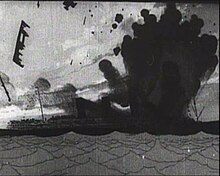 A still from the film showing the RMS Lusitania engulfed in smoke after being torpedoed
A still from the film showing the RMS Lusitania engulfed in smoke after being torpedoed 
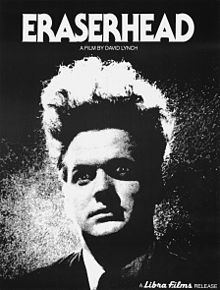 Theatrical release poster
Theatrical release poster 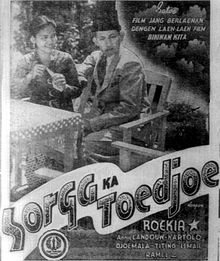 Newspaper advertisement
Newspaper advertisement 





 The Pathé Brothers, by Adrien Barrère. (from History of film)
The Pathé Brothers, by Adrien Barrère. (from History of film) 
































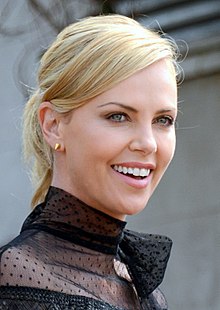 Théron au Festival de Cannes 2015
Théron au Festival de Cannes 2015 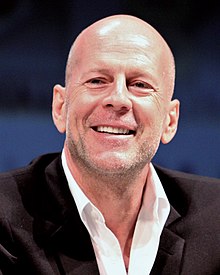 Bruce Willis at the 2010 San Diego Comic-Con for The Expendables
Bruce Willis at the 2010 San Diego Comic-Con for The Expendables  Orson Welles at work on The Magnificent Ambersons (1942)
Orson Welles at work on The Magnificent Ambersons (1942)  Nolan at the 2013 premiere of Man of Steel
Nolan at the 2013 premiere of Man of Steel  Kapoor at a promotional event for Teri Meri Kahaani in 2012
Kapoor at a promotional event for Teri Meri Kahaani in 2012  Leeteuk during Kiss The Radio public broadcast in 2009
Leeteuk during Kiss The Radio public broadcast in 2009  The 2021 recipient: Ariana DeBose
The 2021 recipient: Ariana DeBose 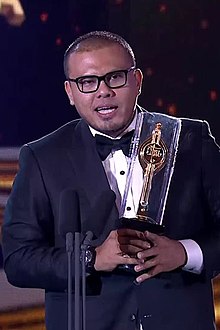 Current recipient: Joko Anwar
Current recipient: Joko Anwar 




